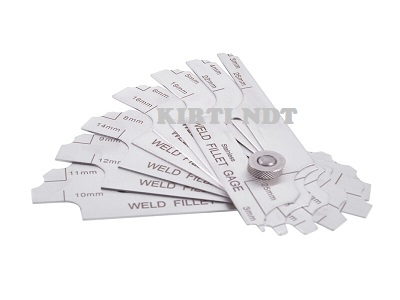The Role of Gauge Fillet Weld in Structural Integrity: What You Need to Know
The Role of Gauge Fillet Weld in Structural Integrity: What You Need to Know
Blog Article
Innovative Approaches to Fillet Weld Examination and Screening: Enhancing Weld Quality and Compliance Criteria
In the world of welding, the quality and integrity of fillet welds play a crucial role in guaranteeing the structural stability and integrity of various industrial components. With the constant drive for improved performance and compliance with strict requirements, the expedition of innovative techniques to fillet weld examination and screening has actually become vital.
Advanced Non-Destructive Testing Techniques
Using state-of-the-art innovations, progressed non-destructive testing approaches play a vital function in making sure the honesty and quality of fillet welds. These techniques, such as phased array ultrasonic testing (PAUT) and magnetic bit testing (MPT), offer detailed insights right into the weld's interior framework without causing any type of damages to the product. PAUT, for example, makes use of numerous ultrasonic elements to inspect the weld from numerous angles, giving an extensive visualization of prospective issues like absence of blend or fractures.
In A Similar Way, MPT works in finding surface-breaking defects by applying a magnetic field and iron particles to the weld location. This method is especially beneficial for recognizing interruptions that may jeopardize the weld's toughness. By utilizing these advanced non-destructive screening techniques, weld examiners can accurately evaluate the high quality of fillet welds, ensuring conformity with industry standards and regulations. The ability to spot problems at an early stage not only enhances weld top quality but likewise prevents costly rework or failures in architectural honesty, highlighting the relevance of these cutting-edge testing methods in welding evaluations.
Robotics and Automation in Examination

The assimilation of robotics and automation has actually revolutionized the evaluation procedure for fillet welds, boosting efficiency and accuracy in high quality assessment. Robotics provide specific control and repeatability in checking welds, making sure reliable and consistent outcomes. Automated systems can be configured to adhere to specific assessment courses, guaranteeing complete coverage of welds and minimizing the danger of human error.
Robot evaluation systems equipped with advanced sensors can discover and measure weld features with high precision, offering in-depth information for evaluation. These systems can recognize flaws such as splits, lack of combination, and porosity, making it possible for prompt corrective actions to be taken. Additionally, robotics and automation allow for real-time data collection and analysis, supplying immediate comments to operators and facilitating quick decision-making procedures.
In addition, the usage of robotics and automation in fillet weld evaluation improves overall performance by decreasing evaluation times and boosting inspection throughput. By enhancing the assessment procedure, suppliers can make certain weld high quality and compliance standards are met efficiently, ultimately resulting in set you back financial savings and enhanced product top quality.
Making Use Of Artificial Intelligence for Analysis
Fabricated knowledge plays a crucial function in boosting the effectiveness and precision of evaluation in fillet weld inspection procedures. AI algorithms can swiftly process vast quantities of information from weld assessments, discovering defects or incongruities that might be challenging to determine with the nude eye.
Additionally, AI systems can discover from previous assessment information, continuously enhancing their ability to recognize possible problems and inconsistencies in fillet welds. This adaptive discovering capacity enhances the general top quality control process, lowering the possibility of human error and making certain that welds meet the called for standards. By integrating expert system into fillet weld evaluation, markets can attain greater levels of effectiveness, uniformity, and compliance in their assessment techniques.
Portable Tools for On-Site Inspection
Enhancing area examination efficiency, the adoption of mobile tools transforms on-site evaluation processes for fillet welds. These devices use adaptability and convenience, enabling assessors to conduct detailed examinations in different areas, consisting of difficult or remote environments. Portable tools such as ultrasonic testing devices, magnetic fragment examination tools, and electronic radiography systems give real-time data and high-resolution imaging abilities, making it possible for fast decision-making and prompt responses on weld high quality.
One considerable benefit of portable devices is their ability to improve assessment procedures, decreasing downtime and improving general efficiency - Gauge Fillet Weld. Inspectors can easily move these tools to different job websites, eliminating the requirement for delivering heavy equipment or components to off-site centers. Additionally, the transportability of these tools promotes cost-effectiveness by minimizing transport expenses and accelerating assessment timelines
Additionally, making use of mobile tools for on-site inspection advertises aggressive quality assurance steps, as inspectors can without delay determine and attend to any kind of possible welding flaws or discrepancies. By including these ingenious modern technologies right into on-site inspection practices, welding experts can make sure compliance with sector criteria and boost weld high quality, eventually resulting in enhanced structural stability and security in different welding applications.
Assimilation of Data Monitoring Systems
Having optimized on-site assessment procedures via the application of mobile devices, the following stage entails the seamless combination of information administration systems to further boost effectiveness and data evaluation capacities in fillet weld evaluation and screening. By incorporating data monitoring systems right into the assessment process, companies can improve data collection, storage space, and analysis. This assimilation enables real-time tracking of weld quality, prompt recognition of issues, and timely decision-making to fix any type of concerns that may occur during the assessment process.
Information management systems play an important role in systematizing inspection information, helping with easy gain access to for accredited workers, and guaranteeing information stability and safety and security. Via the integration of these systems, examiners can generate comprehensive reports, track historic information for pattern evaluation, and improve general procedure effectiveness. The combination of data view publisher site management systems allows seamless communication in between different stakeholders involved in the evaluation process, fostering cooperation and enhancing overall quality control steps. Inevitably, the assimilation of data management systems offers to elevate the standards of fillet weld examination and testing, making sure conformity with sector laws and enhancing weld high quality.
Verdict
Finally, cutting-edge strategies to fillet weld assessment and testing have actually dramatically boosted weld high quality and conformity criteria. original site Advanced non-destructive screening approaches, robotics, automation, man-made intelligence, mobile tools, and data monitoring systems have revolutionized the way weld evaluations are conducted. By making use of these technologies, sectors can make certain that welds satisfy the called for high quality standards and regulations, inevitably improving general efficiency and safety in welding procedures.

Having actually maximized on-site examination processes through the utilization of portable devices, the following phase entails the smooth integration of data monitoring systems to additionally boost efficiency and information analysis capacities in fillet weld evaluation and testing. Inevitably, the combination of data monitoring systems serves to boost the requirements of fillet weld inspection and testing, making sure conformity with market regulations and boosting weld top quality.

Report this page